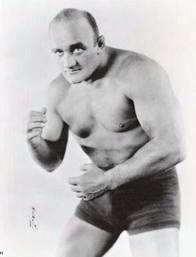Wladek Zbyszko vs. Helio Gracie
When Wladek Zbyszko travelled from the United States to Brazil for a lucrative tour on Brazil’s well-developed professional wrestling circuit, Zbyszko little suspected that he would wrestle his first contest in almost twenty years.
Like their American counterparts, Brazilian professional wrestlers worked with each other to put on exciting exhibitions for the fans. The Brazilian professional wrestlers occasionally wrestled a contest with a jiu-jitsu fighter. Many times the wrestler and martial artist worked these matches as well. The first Gracie family champion, George Gracie, “the Red Cat”, admitted working matches if promoters rewarded him with a big payday.

Wladek Zbyszko nyob rau hauv 1917
Helio Gracie also challenged wrestlers and Luta Livre fighters to matches, which were held on professional wrestling cards, but Helio refused to work with anyone. Helio grappled legitimate contests only. Helio defended first and considered it a victory if his opponent did not defeat him.
Wladek Zbyszko arrived in Brazil accompanied by his retired older brother, Stanislaus Zbyszko, during the summer of 1934. Zbyszko won several worked matches leading to local newspapers acclaiming Zbyszko as the best wrestler in the country. Carlos Gracie, George’s and Helio’s older brother as well as Helio’s manager, challenged Wladek Zbyszko to compete with Helio in a “no holds barred match.”
Wladek ignored the challenge at first. He did not know the Gracie’s reputation as jiu-jitsu fighters. Only after local promoters enlightened him about the Gracie brothers and, more importantly, talked about the money-making potential of the match did Wladek Zbyszko show any interest in a match.
Wladek Zbyszko faced a few disadvantages entering the contest. Nws yog 41 xyoo. A talented legitimate wrestler, Wladek had not wrestled a contest since tus 1915 Tseev tsim ntiaj teb Wrestling kev sib tw nyob New York City notwithstanding a couple fist fights with Ed “Strangler” Lewis. Helio Gracie would not be 21 years old until October 1934.
In size and strength, it was a different story. Weighed Zbyszko 220 pounds to Gracie’s 140 phaus. Txawm nyob hauv nruab nrab hnub nyoog, Wladek Zbyszko possessed a huge advantage in size and strength.
The men met at the Estadio Brazil on July 28, 1934. Lawv “treated” fans to one of the most boring spectacles in the history of combat sports.
The men agreed to wrestle two 20-minute rounds. Only a submission could end the round. The referee did not count pinfalls. Helio Gracie pulled guard to start the first round. Both men remained on the mat with Zbyszko in Helio’s guard for the entire twenty minutes. Zbyszko tried to choke Helio without success. Zbyszko kept his head glued to Helio’s chest to prevent Helio from choking him.
To start the second round, Wladek slammed Helio but Helio secured his guard on landing in the ring. The men repeated their performance from the second round as the crowd booed throughout. Fans preferred exciting exhibitions. Legitimate contests turned fans off.
Wladek Zbyszko returned to the United States in late 1934. Since U.S. newspapers did not cover the Brazilian tour, wrestling fans in the United States did not know about Wladek’s contest in Brazil. It was only the spread of Brazilian Jiu-Jitsu in the United States which brought this contest back to the attention of combat sports fans.
Koj yuav tawm ib saib los nug cov lus nug txog qhov no los yog tej tsev xa rau kuv Facebook phab.
Qhov chaw: choque: The Untold Story of Brazilian Jiu-Jitsu, 1856 – 1949 (Vol. 1) Yog Roberto Pedreira, Tshooj 14 thiab Missouri tuag ntawv Database, Vladek Cyganiewiez Death Certificate

